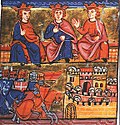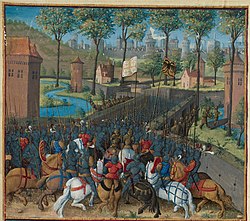Eleanor of Aquitaine
Eleanor of Aquitaine (c. 1122 – March 31, 1204) was the daughter of William X of Aquitaine. She had a younger sister called Petronilla of Aquitaine. She brought the province of Aquitaine to England when she married Henry II of England. It stayed under English control for 300 years.
| Eleanor of Aquitaine | |
|---|---|
| Queen consort of France Queen consort of England
| |

| |
| Queen Eleanor | |
| Duchess of Aquitaine | |
| Reign | 9 April 1137 – 1 April 1204 |
| Predecessor | William X |
| Successor | John |
| Queen consort of France | |
| Tenure | 1 August 1137 – 21 March 1152 |
| Coronation | 25 December 1137 |
| Queen consort of England | |
| Tenure | 19 December 1154 – 6 July 1189 |
| Coronation | 19 December 1154 |
| Issue | |
| Marie, Countess of Champagne Alix, Countess of Blois William IX, Count of Poitiers Henry the Young King Matilda, Duchess of Saxony Richard I the Lionheart, King of the English Geoffrey II, Duke of Brittany Leonora, Queen of Castile Joan, Queen of Sicily John Lackland, King of England | |
| House | House of Poitiers |
| Father | William X, Duke of Aquitaine |
| Mother | Aenor de Châtellerault |
| Burial | Fontevraud Abbey |
Life
Eleanor inherited land in France at the age of 15. She married Louis VII of France on July 22, 1137, and had two daughters:
The marriage was later annulled, as there were no male children.
Eleanor then married Henry II of England on May 18, 1152, and had eight children, including:
- William, who died at the age of 3.
- Henry the Young King
- Richard I of England
- John I of England
- Matilda of England, Duchess of Saxony
- Joan/Joanna of England
- Eleanor of England
Eleanor was greatly known for her work in the Second Crusade, for she inspired many people to join.
Eleanor supported a revolt by her children against their father's rule in 1173. This revolt was unsuccessful, and King Henry II was so angry that he locked her away in a prison. In 1189, after King Henry II died and her son, Richard, came to be the king, Eleanor was freed. Ten years later, in 1199, Richard died so she supported her youngest son John to take the English throne against the claim of her grandson Arthur of Brittany. In 1202 during the campaign at Mairebeau, she continued to oppose Arthur. Upon John’s ascension, Eleanor retired to Aquitaine, spending most of her remaining life at a monastery. She died there on April 1, 1204.[1][2][3]
Eleanor Of Aquitaine Media
France, Aquitaine and Poitiers in 1154 with the expansion of the Plantagenet lands
Eleanor's rock crystal vase, which she gave Louis as a wedding giftLouvre Museum
Louis VII taking the cross, by Sébastien Mamerot, c. 1490
Henry II of England, drawn by Matthew Paris
France 1154–1184 and the Angevin Empire
The Palace of Poitiers, the seat of the counts of Poitou and dukes of Aquitaine in the 10th through to the 12th centuries, where Eleanor's court inspired tales of the Court of Love.
References
- ↑ "Eleanor of Aquitaine." Encyclopedia of World Biography. Detroit: Gale, 1998. Biography In Context. Web. 27 Feb. 2013.
- ↑ "Eleanor of Aquitaine." World Book Advanced. World Book, 2013. Web. 27 Feb. 2013.
- ↑ "Eleanor of Aquitaine." World History: Ancient and Medieval Eras. ABC-CLIO, 2013. Web. 27 Feb. 2013.
Other websites
![]() Media related to Eleanor of Aquitaine at Wikimedia Commons
Media related to Eleanor of Aquitaine at Wikimedia Commons









